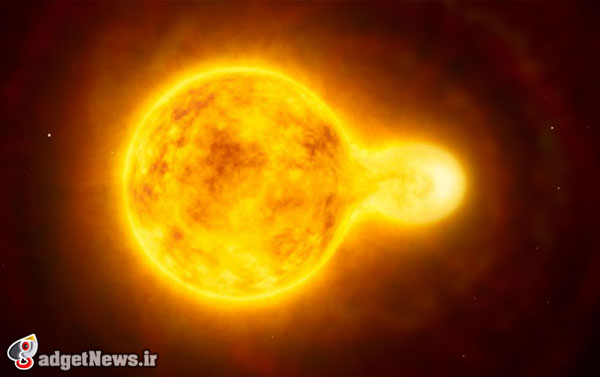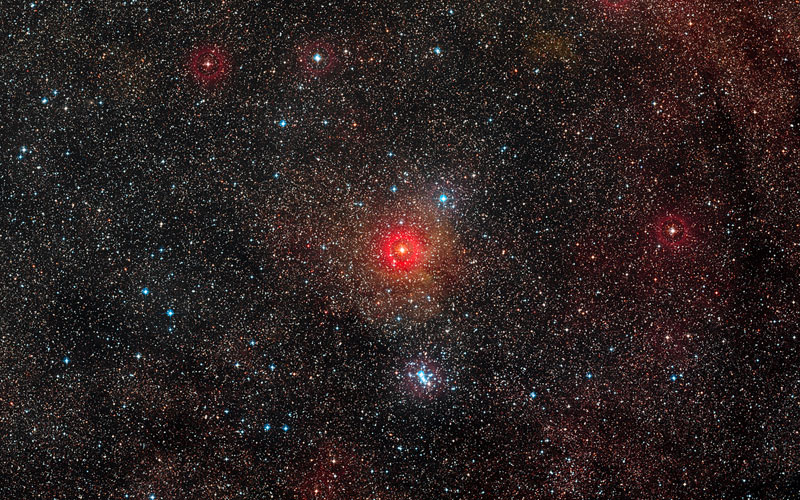
بهتازگی دانشمندان موفق شدهاند نسخهی هیولامانند خورشید را پیدا کنند که گفته میشود بزرگترین ستارهی شناخته شده در خانوادهی ستارههای زرد است.ستارهی فراغول زرد که اندازهی آن ۱۳۰۰ برابر خورشید است و جزو ۱۰ ستارهی بزرگی است که تاکنون کشف شده است.
طول موجی که این ستارهی غولپیکر میتابد بسیار شبیه به خورشید است اما قطر آن ۱۳۰۰ بار بزرگتر از یگانه ستارهی منظومهی شمسی است. به عبارت دیگر اگر خورشید را از مرکز منظومهی شمسی برداریم و این ستارهی غولپیکر را جایگزین کنیم٬ همهی سیارات از عُطارد تا مشتری را دربرخواهد گرفت. جالب است بدانید که این ستارهی غول پیکر تنها نیست و ستارهی همدم کوچکتری٬ چهرهبهچهرهی او در حال گردش است.
این ستارهی غولپیکر HR 5171 A نام دارد و در فاصلهی ۱۲ هزار سال نوری از ما در صورت فلکی قنطورس قرار دارد. پیش از این دانشمندان میدانستند که این ستاره بسیار غولپیکر است اما از اندازهی دقیق آن بهخوبی مطلع نبودند.
به نقل از New Scientist ٬ گروهی از دانشمندان فرانسوی به سرپرستی اولیویه شنو از رصدخانهی نیس٬ با استفاده از ابرتلسکوپهای VLT در آتاکامای شیلی نگاه دقیقتری به این ستاره انداختند و متوجه شدند که اندازهی این ستارهی غولپیکر٬ دو برابر آنچیزی است که پیش از این تصور میشد. این ستاره در دستهی متفاوتی از مرحلهی تحول ستارهها قرار دارد؛ بنابراین به گونهای دیگری از ستارهها موسوم به ستارههای سرخ متعلق است.
خورشید بادامزمینیمانند
هم ستارههای زرد و هم ستارههای سرخ ممکن است فراغول باشند اما تصور میشد که اندازهی ستارههای فراغول زرد حداکثر ۷۰۰ برابر خورشید باشد. اندازهگیریهای تازهی ستارهی HR 5171 A نشان داد که این نوع ستارهها میتوانند بزرگتر هم باشند. ستارهی HR 5171 A حدوداً ۵۰ درصد بزرگتر از ستارهی ابطالجوزا – نهمین ستارهی پرنور آسمان- در صورت فکلی جبار است.

یکی دیگر از شگفتیهای پژوهش گروه شنو٬ یافتن برادر کوچکتر این ستارهی غولپیکر بود. رصدهای پیشین نشان دادند که روشنایی ستارهی HR 5171 A تغییر میکند. گروه پژوهش معلوم کرد که این نوسان به علت حضور ستارهای کوچکتر در نزدیکی آن است. اندازهی این ستارهی حدود یکسوم ستارهی غولپیکر است. این دو ستاره به دور یکدیگر در حال گردشاند و منظومهای دوتایی تشکیل دادهاند. با وجود اینکه فاصلهی مرکزشان از یکدیگر برابر با فاصلهی خورشید تا سیارهی زحل است٬ ستارهی HR 5171 A آنقدر بزرگ است که با ستارهی همدم خود چهرهبهچهره شده و سطح آن را لمس میکند. به همین علت ساختاری بادامزمینی مانند ایجاد کردهاند.
منبع : newscientist
Largest ever yellow star is 1300 times bigger than sun
A monster version of our sun has been found, the largest known member of the family of yellow stars to which our sun belongs.
The whopper sun emits light in similar wavelengths as our sun but its diameter is over 1300 times larger. That means it would engulf all the planets between Mercury and Jupiter if placed at the centre of our solar system. The star's size also means it is touching its smaller, companion star (see diagram, below).
Dubbed HR 5171 A, the star is located in the constellation Centaurus around 12,000 light years from Earth. It was already known to be a hypergiant, the largest class of stars, but its exact size hadn't been well studied.
Now a team led by Oliver Chesneau of the Côte d'Azur Observatory in Nice, France, has taken a closer look with the Very Large Telescope in Atacama, Chile. They report that it is twice as large as expected.
It still isn't the largest star we know about – that crown goes to UY Scuti, which is around 1700 times larger than our sun. But UY Scuti is in a different stage of stellar evolution and so belongs to a different family of stars called red stars.
Peanut sun
Both red and yellow stars can be hypergiants, but yellow hypergiants were previously thought to be at most 700 times the size of the sun. The new measurement of HR 5171 A shows they can be much bigger. HR 5171 A is 50 per cent larger than the red hypergiant Betelgeuse, which is located in the constellation Orion and is the ninth brightest star in the night sky.
Another surprise for Chesneau's team was the discovery that HR 5171 A has a little brother. Previous observations suggested the star varied in brightness. Now the team has shown that this is due to a companion star that is around one third its size.
The two stars orbit each other, forming a binary system. However, though their centres are separated by more than the distance between our sun and Saturn, HR 5171 A is so large that the two are touching, forming a continuous peanut-shaped structure. Guess this star system ain't big enough for two.
 گجت نیوز آخرین اخبار تکنولوژی، علم و خودرو
گجت نیوز آخرین اخبار تکنولوژی، علم و خودرو 





